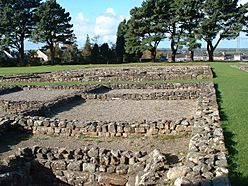Segontium facts for kids
Quick facts for kids Segontium |
|
|---|---|
 |
|
| Founded | CE 77 or 78 |
| Abandoned | CE 4th century |
| Place in the Roman world | |
| Province | Britannia |
| Structure | |
| — Stone structure — | |
| Built | 2nd century |
| — Wood and earth structure — | |
| Built | 1st century |
| Location | |
| Coordinates | 53°08′14″N 4°15′57″W / 53.1373°N 4.2659°W |
| Town | Caernarfon |
| County | Gwynedd |
| Country | Wales |
| Reference | |
| UK-OSNG reference | SH485624 |
| Site notes | |
| Controlled by | Cadw |
Segontium was an important Roman fort located near Caernarfon in Gwynedd, North Wales. It was a key military base for the Romans in ancient Britain. Today, you can still see the remains of this historic site.
Contents
What's in a Name?
The name Segontium likely comes from the nearby River Seiont. It might also be from an older British settlement named after the river. The name is a Latin version of a word that means "strong place." This makes sense for a fort!
A Look Back: Segontium's History
Roman Times
The Roman fort of Segontium was built by a Roman general named Agricola. This happened in AD 77 or 78, after he had taken control of the Ordovices people in North Wales.
Segontium was the most important Roman fort in northern Roman Wales. It was built to house about a thousand auxiliary soldiers. These were soldiers who helped the main Roman legions. A Roman road connected Segontium to the big Roman army base in Chester, called Deva Victrix.
Unlike the later Caernarfon Castle, Segontium was built on higher ground. This gave the Romans a great view of the Menai Straits, helping them watch for any threats.
At first, the fort had timber defences (walls made of wood and earth). These were later rebuilt with strong stone in the early 2nd century. Around the same time, a large house was built inside the fort. It even had its own small bathhouse! This house was probably for an important Roman official. This person might have been in charge of mining for valuable minerals in the area.
By the year 120, fewer soldiers were stationed at Segontium. In the 3rd century, about 500 soldiers from the Cohors I Sunicorum were based there. This group of soldiers originally came from a place called Gallia Belgica.
Over the 3rd and 4th centuries, the fort became smaller. Its main job was to protect the coast of North Wales. It guarded against Irish raiders and pirates who might attack. Coins found at Segontium show that people lived there until at least 394 AD.
Medieval Times
Segontium is mentioned in an old book called the Historia Brittonum. This book lists 28 important cities in Britain after the Romans left. Segontium was likely one of them, possibly called Cair Segeint.
Later, in the 11th century, the Normans built a small castle mound, called a motte, nearby. This led to the start of the town we now know as Caernarfon. After the Edwardian conquest in the 13th century, the famous Caernarfon Castle was built. It replaced the earlier Norman structures.
Segontium Today
Even though a modern road, the A4085, goes through the site, most of the fort's original foundations are still preserved. You can visit the site and explore what remains. Cadw, a Welsh government body, looks after the site.
Around the fort, archaeologists have also found traces of a Roman town. This included a Roman temple dedicated to the god Mithras, known as the Caernarfon Mithraeum, and a cemetery.
Segontium in Stories
Segontium appears in old Welsh stories and modern books!
- In the Mabinogion, a collection of medieval Welsh tales, Segontium is mentioned. In the story "The dream of Macsen Wledig", the Emperor Macsen dreams of a beautiful woman, Saint Elen. He finds her at "the fort at the mouth of the Seiont."
- The fort is also suggested as the location of Snowdon or Synadowne in the story Libeaus Desconus.
- Wallace Breem's novel Eagle in the Snow starts and ends at Segontium after the Romans left. It even talks about its temple of Mithras.
- The fort also features in The Crystal Cave and The Hollow Hills. These are part of Mary Stewart's popular Merlin trilogy.
Images for kids
See also
 In Spanish: Segontium para niños
In Spanish: Segontium para niños
- Caer Gybi at Holyhead—another Roman fort built to help Segontium defend against Irish raiders.
- Pen-y-Gwryd - a place along the Roman road between Segontium and Deva Victrix (Chester).







